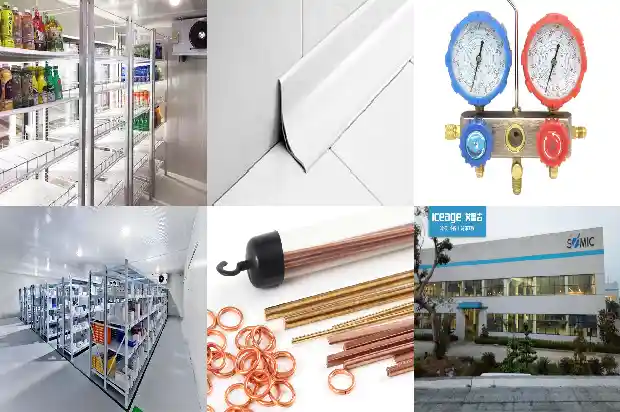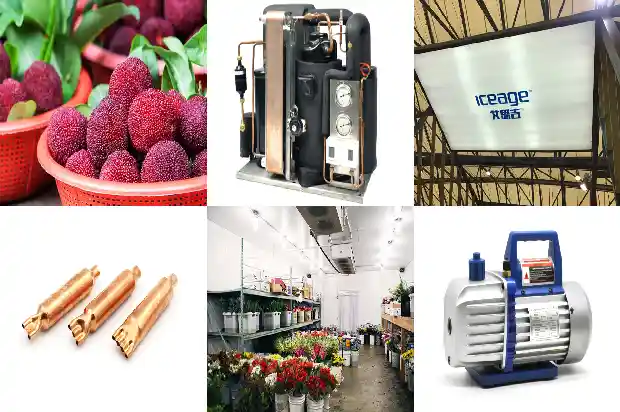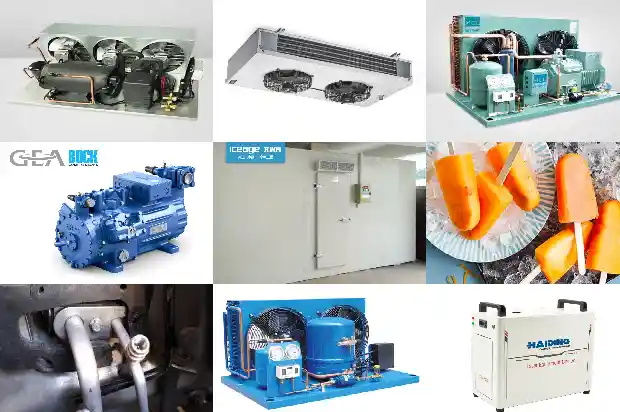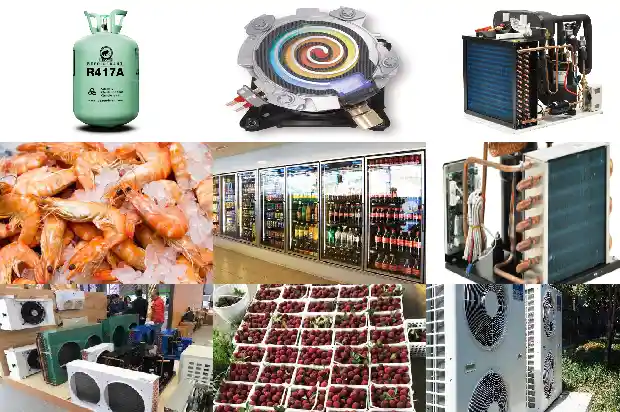Have You Encountered These Main Reasons for the Burning of Refrigeration Compressor Windings?
2025-04-24
The damage to the motor coil is mainly manifested as the destruction of the insulation layer of the stator winding (short circuit), open circuit, etc. After the stator winding is damaged, it is difficult to be detected in time, and it may eventually lead to the burning of the winding. After the winding is burned out, some phenomena or direct causes leading to the burnout are covered up, making it difficult to conduct post-mortem analysis and cause investigation.
Starting from these aspects, it is not difficult to find that the reasons for the burning of the winding are nothing more than the following six:
(1) Abnormal load and locked rotor;
(2) Winding short circuit caused by metal chips;
(3) Contactor problems;
(4) Power supply phase loss and abnormal voltage;
(5) Insufficient cooling;
(6) Using the compressor to evacuate.
(1) Abnormal load and locked rotor;
(2) Winding short circuit caused by metal chips;
(3) Contactor problems;
(4) Power supply phase loss and abnormal voltage;
(5) Insufficient cooling;
(6) Using the compressor to evacuate.
In fact, the damage to the motor caused by multiple factors is more common.
Factor 1: Abnormal Load and Locked Rotor
The motor load includes the load required to compress the gas and the load required to overcome mechanical friction. An excessive compression ratio or a large pressure difference will make the compression process more difficult; while the increase in frictional resistance caused by lubrication failure, as well as the motor locked rotor under extreme circumstances, will greatly increase the motor load. The failure of lubrication and the increase in frictional resistance are the primary reasons for abnormal load.
Liquid return dilutes the lubricating oil, the lubricating oil overheats, the lubricating oil cokes and deteriorates, and lack of oil, etc., will all damage the normal lubrication and lead to lubrication failure. Liquid return dilutes the lubricating oil, affecting the formation of the normal oil film on the friction surface, and even washing away the original oil film, increasing friction and wear.
Overheating of the compressor will cause the lubricating oil to become thin at high temperatures or even coke, affecting the formation of a normal oil film. If the oil return of the system is not good and the compressor is short of oil, it is naturally impossible to maintain normal lubrication. The crankshaft rotates at a high speed, and the connecting rod and piston move at a high speed. The friction surface without the protection of the oil film will heat up rapidly, and the local high temperature will cause the lubricating oil to evaporate or coke quickly, making lubrication at this part more difficult, and serious local wear can be caused within a few seconds.
For small-power compressors (such as refrigerator and household air conditioner compressors), due to the small torque of the motor, the phenomenon of locked rotor (the motor cannot rotate) often occurs after the lubrication fails, and it enters the "locked rotor - thermal protection - locked rotor" vicious cycle. It is only a matter of time before the motor burns out. However, the motor torque of a large-power semi-hermetic compressor is very large, and local wear will not cause the locked rotor. The motor power will increase with the load within a certain range, resulting in more serious wear, and even causing serious damage such as cylinder biting (the piston is stuck in the cylinder) and the fracture of the connecting rod. The current during the locked rotor (locked rotor current) is approximately 4-8 times the normal operating current.
At the moment of motor starting, the peak value of the current can be close to or reach the locked rotor current. Since the heat generated by the resistance is proportional to the square of the current, the current during starting and locked rotor will cause the winding to heat up rapidly. The thermal protection can protect the electrode during the locked rotor, but it generally does not respond quickly and cannot prevent the temperature change of the winding caused by frequent starting and so on. Frequent starting and abnormal load subject the winding to high temperature tests, which will reduce the insulation performance of the enameled wire. In addition, the load required to compress the gas will also increase with the increase of the compression ratio and the pressure difference.
Therefore, using a high-temperature compressor for low-temperature applications or a low-temperature compressor for high-temperature applications will affect the motor load and heat dissipation, which is inappropriate and will shorten the service life of the electrode. After the insulation performance of the winding deteriorates, if there are other factors (such as metal chips forming a conductive loop, acidic lubricating oil, etc.) cooperating, it is very easy to cause a short circuit and damage.
Factor 2: Winding Short Circuit Caused by Metal Chips
The metal chips mixed in the winding are the main culprits for short circuits and low insulation resistance to ground. The sources of metal chips include copper pipe chips left during construction, welding slag, and metal chips dropped when the compressor is internally worn and components are damaged (such as the valve plate breaking), etc.
For hermetic compressors (including hermetic scroll compressors), these metal chips or particles will fall on the winding.
For semi-hermetic compressors, some particles will flow in the system along with the gas and lubricating oil, and finally gather in the winding due to magnetism; while some metal chips (such as those generated during bearing wear and the wear between the motor rotor and the stator (rubbing)) will directly fall on the winding. After metal chips gather in the winding, it is only a matter of time before a short circuit occurs.
In a two-stage compressor, the return gas contains lubricating oil, which already makes the compression process precarious.
Factor 3: Winding Short Circuit Caused by Metal Chips
It is extremely important to select the contactor correctly according to the load. When using a single contactor, the rated current of the contactor must be greater than the rated current value (RLA) on the motor nameplate. At the same time, the contactor must be able to withstand the locked rotor current of the motor. If there are other loads downstream of the contactor, such as the motor fan, etc., it must also be considered.
When using two contactors, the locked rotor rating of each contactor's divided winding must be equal to or greater than the locked rotor rating of the compressor's half winding.
Contactors with small specifications or poor quality cannot withstand the impact of large currents during compressor starting, locked rotor, and low voltage, and are prone to phenomena such as single-phase or multi-phase contact jitter, welding, or even falling off, causing damage to the motor.
If the contactor is selected with a small size, the contacts cannot withstand the arc and the high temperature generated by frequent start-stop cycles or unstable control loop voltages, and may be welded together or fall off from the contact holder. The welded contacts will produce a permanent single-phase state, causing the overload protector to continuously cycle on and off.
Therefore, when the motor is burned out, checking the contactor is an essential procedure. The contactor is an important reason for motor damage that is often overlooked.
Factor 4: Power Supply Phase Loss and Abnormal Voltage
Abnormal voltage and phase loss can easily damage any motor. The variation range of the power supply voltage should not exceed ±10% of the rated voltage. The voltage unbalance between the three phases should not exceed 5%. High-power motors must be independently powered to prevent low voltage caused by the starting and operation of other high-power equipment on the same line.
The power cord of the motor must be able to carry the rated current of the motor. If the compressor is running when a phase loss occurs, it will continue to run but will have a large load current. The motor winding will overheat quickly, and under normal circumstances, the compressor will be protected by thermal protection.
When the motor winding cools down to the set temperature, the contactor will close, but the compressor cannot start, resulting in a locked rotor, and it enters the "locked rotor - thermal protection - locked rotor" vicious cycle.
The calculation method for the percentage of voltage unbalance is: the ratio of the maximum deviation value between the phase voltage and the average value of the three-phase voltage to the average value of the three-phase voltage.
For example: For a nominal 380V three-phase power supply, the measured voltages at the compressor terminals are 380V, 366V, and 400V respectively. The average value of the three-phase voltage can be calculated as 382V, and the maximum deviation is 20V, so the percentage of voltage unbalance is 5.2%. As a result of voltage unbalance, the unbalance of the load current during normal operation is 4-10 times the percentage of voltage unbalance. In the previous example, a 5.2% unbalanced voltage may cause a 50% current unbalance.
The Standard Publication of Motors and Generators by the National Electrical Manufacturers Association of the United States points out that the percentage increase in the temperature rise of the phase winding caused by unbalanced voltage is approximately twice the square of the percentage of voltage unbalance. In the previous example, the percentage of voltage unbalance is 5.2, and the percentage increase in the winding temperature is 54%. The result is that one phase winding overheats while the temperatures of the other two windings are normal.
Factor 5: Insufficient Cooling
Compressors with relatively large power are generally of the suction gas cooling type. The lower the evaporation temperature, the smaller the mass flow of the system tends to be. When the evaporation temperature is very low (exceeding the manufacturer's regulations), the flow rate is not sufficient to cool the motor, and the motor will operate at a higher temperature. Air-cooled compressors (generally not exceeding 10HP) have less dependence on the return gas, but there are clear requirements for the ambient temperature of the compressor and the cooling air volume.
A large leakage of refrigerant will also reduce the mass flow of the system, and the cooling of the motor will be affected. For some unattended refrigeration equipment, it is often not until the refrigeration effect is very poor that a large leakage of refrigerant is found.
After the motor overheats, it will be protected frequently. Some users do not check the cause thoroughly and even short-circuit the thermal protector. Before long, the motor will burn out. Compressors all have a safe operating condition range, and the main factors considered in the safe operating condition are the load and cooling of the compressor and the motor.
Factor 6: Using the Compressor to Evacuate
Some on-site construction personnel in the refrigeration industry still retain the past habit of using the compressor to evacuate. Air acts as an insulating medium. After evacuating a closed container, the discharge phenomenon between the electrodes inside is likely to occur.
As the vacuum degree inside the compressor housing deepens, the insulating medium is lost between the exposed terminals in the housing or between the windings with slight damage to the insulation layer.
Therefore, it is prohibited to use the compressor to evacuate, and when the system and the compressor are in a vacuum state (after evacuation and before adding refrigerant), it is strictly prohibited to power on the compressor.

Factor 1: Abnormal Load and Locked Rotor
The motor load includes the load required to compress the gas and the load required to overcome mechanical friction. An excessive compression ratio or a large pressure difference will make the compression process more difficult; while the increase in frictional resistance caused by lubrication failure, as well as the motor locked rotor under extreme circumstances, will greatly increase the motor load. The failure of lubrication and the increase in frictional resistance are the primary reasons for abnormal load.
Liquid return dilutes the lubricating oil, the lubricating oil overheats, the lubricating oil cokes and deteriorates, and lack of oil, etc., will all damage the normal lubrication and lead to lubrication failure. Liquid return dilutes the lubricating oil, affecting the formation of the normal oil film on the friction surface, and even washing away the original oil film, increasing friction and wear.
Overheating of the compressor will cause the lubricating oil to become thin at high temperatures or even coke, affecting the formation of a normal oil film. If the oil return of the system is not good and the compressor is short of oil, it is naturally impossible to maintain normal lubrication. The crankshaft rotates at a high speed, and the connecting rod and piston move at a high speed. The friction surface without the protection of the oil film will heat up rapidly, and the local high temperature will cause the lubricating oil to evaporate or coke quickly, making lubrication at this part more difficult, and serious local wear can be caused within a few seconds.
For small-power compressors (such as refrigerator and household air conditioner compressors), due to the small torque of the motor, the phenomenon of locked rotor (the motor cannot rotate) often occurs after the lubrication fails, and it enters the "locked rotor - thermal protection - locked rotor" vicious cycle. It is only a matter of time before the motor burns out. However, the motor torque of a large-power semi-hermetic compressor is very large, and local wear will not cause the locked rotor. The motor power will increase with the load within a certain range, resulting in more serious wear, and even causing serious damage such as cylinder biting (the piston is stuck in the cylinder) and the fracture of the connecting rod. The current during the locked rotor (locked rotor current) is approximately 4-8 times the normal operating current.
At the moment of motor starting, the peak value of the current can be close to or reach the locked rotor current. Since the heat generated by the resistance is proportional to the square of the current, the current during starting and locked rotor will cause the winding to heat up rapidly. The thermal protection can protect the electrode during the locked rotor, but it generally does not respond quickly and cannot prevent the temperature change of the winding caused by frequent starting and so on. Frequent starting and abnormal load subject the winding to high temperature tests, which will reduce the insulation performance of the enameled wire. In addition, the load required to compress the gas will also increase with the increase of the compression ratio and the pressure difference.
Therefore, using a high-temperature compressor for low-temperature applications or a low-temperature compressor for high-temperature applications will affect the motor load and heat dissipation, which is inappropriate and will shorten the service life of the electrode. After the insulation performance of the winding deteriorates, if there are other factors (such as metal chips forming a conductive loop, acidic lubricating oil, etc.) cooperating, it is very easy to cause a short circuit and damage.
Factor 2: Winding Short Circuit Caused by Metal Chips
The metal chips mixed in the winding are the main culprits for short circuits and low insulation resistance to ground. The sources of metal chips include copper pipe chips left during construction, welding slag, and metal chips dropped when the compressor is internally worn and components are damaged (such as the valve plate breaking), etc.
For hermetic compressors (including hermetic scroll compressors), these metal chips or particles will fall on the winding.
For semi-hermetic compressors, some particles will flow in the system along with the gas and lubricating oil, and finally gather in the winding due to magnetism; while some metal chips (such as those generated during bearing wear and the wear between the motor rotor and the stator (rubbing)) will directly fall on the winding. After metal chips gather in the winding, it is only a matter of time before a short circuit occurs.
In a two-stage compressor, the return gas contains lubricating oil, which already makes the compression process precarious.

Factor 3: Winding Short Circuit Caused by Metal Chips
It is extremely important to select the contactor correctly according to the load. When using a single contactor, the rated current of the contactor must be greater than the rated current value (RLA) on the motor nameplate. At the same time, the contactor must be able to withstand the locked rotor current of the motor. If there are other loads downstream of the contactor, such as the motor fan, etc., it must also be considered.
When using two contactors, the locked rotor rating of each contactor's divided winding must be equal to or greater than the locked rotor rating of the compressor's half winding.

Contactors with small specifications or poor quality cannot withstand the impact of large currents during compressor starting, locked rotor, and low voltage, and are prone to phenomena such as single-phase or multi-phase contact jitter, welding, or even falling off, causing damage to the motor.
If the contactor is selected with a small size, the contacts cannot withstand the arc and the high temperature generated by frequent start-stop cycles or unstable control loop voltages, and may be welded together or fall off from the contact holder. The welded contacts will produce a permanent single-phase state, causing the overload protector to continuously cycle on and off.
Therefore, when the motor is burned out, checking the contactor is an essential procedure. The contactor is an important reason for motor damage that is often overlooked.
Factor 4: Power Supply Phase Loss and Abnormal Voltage
Abnormal voltage and phase loss can easily damage any motor. The variation range of the power supply voltage should not exceed ±10% of the rated voltage. The voltage unbalance between the three phases should not exceed 5%. High-power motors must be independently powered to prevent low voltage caused by the starting and operation of other high-power equipment on the same line.
The power cord of the motor must be able to carry the rated current of the motor. If the compressor is running when a phase loss occurs, it will continue to run but will have a large load current. The motor winding will overheat quickly, and under normal circumstances, the compressor will be protected by thermal protection.
When the motor winding cools down to the set temperature, the contactor will close, but the compressor cannot start, resulting in a locked rotor, and it enters the "locked rotor - thermal protection - locked rotor" vicious cycle.
The calculation method for the percentage of voltage unbalance is: the ratio of the maximum deviation value between the phase voltage and the average value of the three-phase voltage to the average value of the three-phase voltage.
For example: For a nominal 380V three-phase power supply, the measured voltages at the compressor terminals are 380V, 366V, and 400V respectively. The average value of the three-phase voltage can be calculated as 382V, and the maximum deviation is 20V, so the percentage of voltage unbalance is 5.2%. As a result of voltage unbalance, the unbalance of the load current during normal operation is 4-10 times the percentage of voltage unbalance. In the previous example, a 5.2% unbalanced voltage may cause a 50% current unbalance.
The Standard Publication of Motors and Generators by the National Electrical Manufacturers Association of the United States points out that the percentage increase in the temperature rise of the phase winding caused by unbalanced voltage is approximately twice the square of the percentage of voltage unbalance. In the previous example, the percentage of voltage unbalance is 5.2, and the percentage increase in the winding temperature is 54%. The result is that one phase winding overheats while the temperatures of the other two windings are normal.
Factor 5: Insufficient Cooling
Compressors with relatively large power are generally of the suction gas cooling type. The lower the evaporation temperature, the smaller the mass flow of the system tends to be. When the evaporation temperature is very low (exceeding the manufacturer's regulations), the flow rate is not sufficient to cool the motor, and the motor will operate at a higher temperature. Air-cooled compressors (generally not exceeding 10HP) have less dependence on the return gas, but there are clear requirements for the ambient temperature of the compressor and the cooling air volume.
A large leakage of refrigerant will also reduce the mass flow of the system, and the cooling of the motor will be affected. For some unattended refrigeration equipment, it is often not until the refrigeration effect is very poor that a large leakage of refrigerant is found.
After the motor overheats, it will be protected frequently. Some users do not check the cause thoroughly and even short-circuit the thermal protector. Before long, the motor will burn out. Compressors all have a safe operating condition range, and the main factors considered in the safe operating condition are the load and cooling of the compressor and the motor.
Factor 6: Using the Compressor to Evacuate
Some on-site construction personnel in the refrigeration industry still retain the past habit of using the compressor to evacuate. Air acts as an insulating medium. After evacuating a closed container, the discharge phenomenon between the electrodes inside is likely to occur.
As the vacuum degree inside the compressor housing deepens, the insulating medium is lost between the exposed terminals in the housing or between the windings with slight damage to the insulation layer.

Therefore, it is prohibited to use the compressor to evacuate, and when the system and the compressor are in a vacuum state (after evacuation and before adding refrigerant), it is strictly prohibited to power on the compressor.
The above unfavorable factors can also trigger each other: The large current during abnormal load and locked rotor may cause the contactor to weld; the arcing or even welding of a single contact will cause phase unbalance or single phase; phase unbalance will cause heat dissipation problems; insufficient heat dissipation will cause wear; and wear will generate metal chips.
Therefore, the correct installation and use of the compressor, as well as reasonable daily maintenance, can prevent the occurrence of unfavorable factors and are the fundamental methods to avoid damage to the compressor motor.
Related Articles
- What Are the Reasons Why the Temperature in the Quick-freezing Cold Storage Cannot Be Lowered?
- Is the Compressor in the Cold Storage Overheating in Summer? Find the Reasons Here!
- Reasons and Hazards of Liquid Hammer in Refrigeration Compressors
- What are the Reasons and Hazards of Uneven Liquid Distribution in the Refrigeration System?
- Reasons for the Poor Refrigeration Effect of the Cold Storage
- Frosting in the Cold Storage? A Detailed Explanation of the 9 Reasons for Frosting of Air Coolers and 4 Defrosting Methods~~
- These Are the Nine Reasons for the Low-pressure Fault! Haven't You Mastered Them Yet?
- Is the Compressor of the Cold Storage Unit Overheating? Find the Reasons Here!
- A Detailed Analysis of the Nine Reasons for the Low Pressure in the Refrigeration System!
- Reasons for Compressor Oil Deterioration and Oil - adding Operations
- What Are the Common Reasons for Difficulties in Cooling a Cold Storage?
- Analysis of Seven Reasons for Ice Formation in Computer Room Air Conditioners
- Reasons for Frost Formation in Cold Storage and Defrosting Methods
- What Are the Reasons for Insufficient Air Output of Screw Air Compressors?
- Reasons for Pump Body Failures in Cold Storage Compressors
- What are the reasons for the inactivity of the automotive air conditioning compressor? What are the common faults?
- What are the reasons for the frequent start-up and tripping of the refrigerated air dryer in the cold storage?
- Reasons and Solutions for High and Low Condensing Pressure in Air-cooled and Water-cooled Systems
